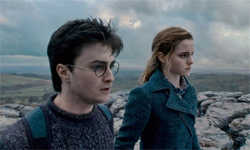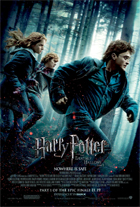Harry Potter and the Deathly Hallows Part 1
|  One doesn’t have to be a cynic in order to speculate that the decision to split J.K. Rowling’s seventh and final Harry Potter novel Harry Potter and the Deathly Hallows into two films was primarily an economic one. Given that the Harry Potter franchise has been an unstoppable decade-long cash cow for Warner Bros., all but guaranteeing a massive international hit every year and a half, it isn’t hard to imagine that studio executives would be desperate to extend the franchise’s lease on life, especially since it provides them with tentpoles for the two biggest movie seasons (Thanksgiving/Christmas and summer). Be that as it may, the cleaving of Rowling’s 759-page finale into two separate films ultimately benefits the material, allowing returning director David Yates and screenwriter Steve Kloves (who has adapted all the films except Order of the Phoenix) to take their time and keep as much of the story as possible while also maintaining a taut narrative pace that makes the film feel shorter than its 146-minute running time. One doesn’t have to be a cynic in order to speculate that the decision to split J.K. Rowling’s seventh and final Harry Potter novel Harry Potter and the Deathly Hallows into two films was primarily an economic one. Given that the Harry Potter franchise has been an unstoppable decade-long cash cow for Warner Bros., all but guaranteeing a massive international hit every year and a half, it isn’t hard to imagine that studio executives would be desperate to extend the franchise’s lease on life, especially since it provides them with tentpoles for the two biggest movie seasons (Thanksgiving/Christmas and summer). Be that as it may, the cleaving of Rowling’s 759-page finale into two separate films ultimately benefits the material, allowing returning director David Yates and screenwriter Steve Kloves (who has adapted all the films except Order of the Phoenix) to take their time and keep as much of the story as possible while also maintaining a taut narrative pace that makes the film feel shorter than its 146-minute running time.Of course, anyone not deeply familiar with the world of Harry Potter won’t have a chance of understanding the story, as Kloves dives right into the narrative en media res, assuming that we are all up to speed with who is who, what is what, and why. And, really, should we expect any different at this point? If you’re not on board by now, you probably never will be (although casual readers/viewers may want to refresh themselves on some of the details before heading into the story if you want to catch all the nuances). Those in the know are aware that things are not going well in the wizarding world, as the evil, snake-like Lord Voldemort (Ralph Fiennes) and his minions have pretty much taken over. Even the stalwart Ministry of Magic has fallen into their hands and been turned into a political sledgehammer to punish those who opposed Voldemort and round up all half-human/half-wizard Mudbloods (insert your own Third Reich metaphor reading here). The thrust of the narrative involves Harry (Daniel Radcliffe) and his longtime friends Ron (Rupert Grint) and Hermione (Emma Watson) setting off on their own to retrieve the Horcruxes, which are otherwise ordinary objects that contain one of seven parts of Volemort’s soul. The only way to kill Voldemort is to find and destroy all the Horcruxes, but the problem is that Harry, Ron, and Hermione don’t know where all of them are and aren’t sure how to destroy them if and when they find them. Thus, The Deathly Hallows takes on an entirely different tone from even the darkest of the previous installments because, for the first time, Harry and his friends do not have the protection of Hogwarts School and Witchcraft and Wizardry and its benevolent professors. Rather, they are completely on their own, cut off from their previous securities, which fully establishes them as adult characters, their arc of growth and maturity having finally reached a peak (the fact that the three main characters are played by the same actors over a 10-year period is absolutely crucial in this regard, making the Harry Potter franchise a truly unique one, intriguingly close in spirit to François Truffaut’s Antoine Doinel cycle of films). The sense of Harry, Ron, and Hermione being on their own is visually underscored by the open landscapes in which they find themselves, which range from foreboding hills to deep forests; Eduardo Serra’s cinematography is consistently gorgeous, even when the beauty has an inherently harrowing edge to it, and we should thank Warner Bros. for dropping the idea of quickly retrofitting the film for 3-D. The openness of the imagery plays in counterpoint to the previous films, which tended to take place in much more enclosed, set-like spaces. Seeing the central trio’s painful new maturity set against dramatic landscapes heightens the emotion and the sense of depth, which the film establishes in the opening minutes with each character leaving behind their families and stepping into unknown terrain. Although there is a host of familiar faces at the beginning of the film, including the is-he-good-or-is-he-evil? Professor Snape (Alan Rickman), the gruff Mad-Eye Moody (Brendan Gleeson), and the entire Weasley family, the majority of the film rests on the shoulders of Harry, Ron, and Hermione, who carry the film’s dramatic weight and its primary action sequences, the best of which involves them breaking into the Ministry of Magic to retrieve an important locket from the throat of none other than the cheerfully sadistic Dolores Umbridge (Imelda Staunton). They also charge the story with more romantic longing and sexual jealousy than in previous entries, which culminates in a sequence in which Voldemort taunts Ron with a fantastical image of Harry and Hermione making out naked. For the most part, The Deathly Hallows is a surprisingly downbeat movie, composed primarily of a series of events that seem to going in Voldemort’s favor despite Harry and company’s desperate attempts otherwise. Yates and Kloves leaven the darkness with some well-timed humor, although not nearly as much as in the previous films, which usually had at least one subplot that was primarily comic in nature. Here, the humor comes as brief sparks in the darkness, reminding us of the characters’ humanity even as the dire nature of their situation becomes ever more impending (the only exception is a scene in which seven of Harry’s friends are changed into his likeness, resulting in some amusing cross-gender imagery that Radcliffe plays perfectly straight). That the film ends on a decidedly dour note shouldn’t come as much of a surprise, as it leaves us on an appropriately steep cliffhanger that will feed right into next summer’s Part 2, thus completing what is surely one of the most audacious (and successful) book-to-movie franchises in cinema history. Copyright ©2010 James Kendrick Thoughts? E-mail James Kendrick All images copyright © Warner Bros. |
Overall Rating: 

 (3)
(3)


